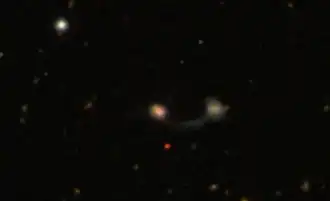IRAS 14394+5332
| IRAS 14394+5332 | |
|---|---|
 SDSS image of IRAS 14394+5332. The galaxy on the right of the image is LEDA 2438180. | |
| Observation data (J2000.0 epoch) | |
| Constellation | Boötes |
| Right ascension | 14h 41m 04.42s[1] |
| Declination | +53° 20′ 09.04″[1] |
| Redshift | 0.105024[1] |
| Heliocentric radial velocity | 31,485 km/s[1] |
| Distance | 1.410 Gly |
| Apparent magnitude (V) | 17.77 |
| Characteristics | |
| Type | ULIRG Sy2[1] |
| Size | ~163,900 ly (50.26 kpc) (estimated)[1] |
| Other designations | |
| 2MASX J14410437+5320088, LEDA 84264, IRAS F14394+5332, IRAS F14394+5332E, SDSS J144104.38+532008.6, AKARI J1441041+532010[1] | |
IRAS 14394+5332 is an ultraluminous infrared galaxy and a galaxy merger located in the constellation of Boötes. It has a redshift of (z) 0.105, estimating the distance to be 1.4 billion light-years from Earth.[1] The galaxy was first discovered by astronomers in 1996 who found it having a total infrared luminosity of 12.04 Lʘ.[2]
Description
IRAS 14394+5332 is described as a triple interacting galaxy system[3] consisting of a spiral galaxy located in western direction and a final-stage double nucleus galaxy merger located in the eastern direction with two closely spaced nuclei, only separating by 2.6 kiloparsecs from each other.[4][5][6][7] A long tidal tail made up diffused radio emission is seen extending by 35 kiloparsecs between the galaxies.[8][9]
The nucleus on the eastern side of the double nucleus galaxy in the IRAS 14394+5332 system, is found to be active. It is described as a Seyfert type 2 galaxy based on optical wavelength observations and is bright at near-infrared wavelengths compared to the faint western nucleus, with it displaying emission lines in its spectrum.[10][8] Furthermore, the morphology of the double nucleus galaxy is complex according to Hubble Space Telescope optical imaging, who described it having two condensation components that seems to be divided by a dust lane.[4] HST imaging also found the structure is irregular with the higher surface brightness feature centering more on the northern condensation component connected with the eastern nucleus.[4]
Observations found the eastern nucleus of the galaxy has detections of nuclear outflows. Based on results, it shows a doubly ionized oxygen emission-line kinematic feature best described by three narrow components; mainly a redmost component and two other components described having blueshift measurements of -700 and -1360 kilometers per second. Data also showed these profiles of doubly ionized oxygen emission lines are noticed as different when compared to the other emission lines.[11]
There are also evidence of ionized outflows in the eastern nucleus of the galaxy within a 0.75 ± 0.12 kiloparsec region, with a mass outflow rate of 3.4+13.8-3.0 Mʘ per year and a kinetic power measuring 0.66+3.12-0.60 percent in energy levels.[9] A total star formation rate of 2.26 ± 0.03 Mʘ per year and a stellar mass of 10.50 ± 0.06 Mʘ has been estimated for the system.[3]
References
- ^ a b c d e f g h "NED Search results for IRAS 14394+5332". NASA/IPAC Extragalactic Database. Retrieved 2025-08-17.
- ^ Murphy, T. W.; Armus, L.; Matthews, K.; Soifer, B. T.; Mazzarella, J. M.; Shupe, D. L.; Strauss, M. A.; Neugebauer, G. (1996). "Visual and Near-Infrared Imaging of Ultraluminous Infrared Galaxies: The IRAS 2 Jy Sample". The Astronomical Journal. 111: 1025. Bibcode:1996AJ....111.1025M. doi:10.1086/117849. ISSN 0004-6256.
- ^ a b Dey, Subhrata; Goyal, Arti; Małek, Katarzyna; Díaz-Santos, Tanio (2024-04-25). "Radio-only and Radio-to-far-ultraviolet Spectral Energy Distribution Modeling of 14 ULIRGs: Insights into the Global Properties of Infrared Bright Galaxies". The Astrophysical Journal. 966 (1): 61. arXiv:2402.10786. Bibcode:2024ApJ...966...61D. doi:10.3847/1538-4357/ad2c93. ISSN 0004-637X.
- ^ a b c Tadhunter, C; Rodríguez Zaurín, J; Rose, M; Spence, R A W; Batcheldor, D; Berg, M A; Ramos Almeida, C; Spoon, H W W; Sparks, W; Chiaberge, M (2018-05-05). "Quantifying the AGN-driven outflows in ULIRGs (QUADROS) – II. Evidence for compact outflow regions from HST [O III] imaging observations". Monthly Notices of the Royal Astronomical Society. 478 (2): 1558–1569. doi:10.1093/mnras/sty1064. ISSN 0035-8711.
- ^ Rodríguez Zaurín, J.; Tadhunter, C. N.; Delgado, R. M. González (2010-04-11). "The properties of the stellar populations in ULIRGs - II. Star formation histories and evolution". Monthly Notices of the Royal Astronomical Society. 403 (3): 1317–1330. arXiv:0911.4052. Bibcode:2010MNRAS.403.1317R. doi:10.1111/j.1365-2966.2009.16075.x. ISSN 0035-8711.
- ^ Meusinger, H.; Stecklum, B.; Theis, C.; Brunzendorf, J. (2001-12-01). "The merger stage of the ultra-luminous infrared galaxy IRAS 03158+4227" (PDF). Astronomy & Astrophysics. 379 (3): 845–854. arXiv:astro-ph/0111521. Bibcode:2001A&A...379..845M. doi:10.1051/0004-6361:20011371. ISSN 0004-6361.
- ^ Veilleux, S.; Kim, D.-C.; Sanders, D. B. (December 2002). "Optical and Near-Infrared Imaging of theIRAS1 Jy Sample of Ultraluminous Infrared Galaxies. II. The Analysis". The Astrophysical Journal Supplement Series. 143 (2): 315–376. arXiv:astro-ph/0207401. Bibcode:2002ApJS..143..315V. doi:10.1086/343844. ISSN 0067-0049.
- ^ a b Dinh-V-Trung; Lo, K. Y.; Kim, D.-C.; Gao, Yu; Gruendl, R. A. (July 2001). "Nature of Widely Separated Ultraluminous Infrared Galaxies". The Astrophysical Journal. 556 (1): 141–149. arXiv:astro-ph/0103285. Bibcode:2001ApJ...556..141D. doi:10.1086/321578. ISSN 0004-637X.
- ^ a b Spence, R A W; Tadhunter, C N; Rose, M; Rodríguez Zaurín, J (2018-05-07). "Quantifying the AGN-driven outflows in ULIRGs (QUADROS) III: measurements of the radii and kinetic powers of eight near-nuclear outflows". Monthly Notices of the Royal Astronomical Society. 478 (2): 2438–2460. doi:10.1093/mnras/sty1046. ISSN 0035-8711.
- ^ Nandi, S; Das, M; Dwarakanath, K S (2021-04-14). "Tracing the evolution of ultraluminous infrared galaxies into radio galaxies with low frequency radio observations". Monthly Notices of the Royal Astronomical Society. 503 (4): 5746–5762. doi:10.1093/mnras/stab275. ISSN 0035-8711.
- ^ Rodríguez Zaurín, J.; Tadhunter, C. N.; Rose, M.; Holt, J. (June 2013). "The importance of warm, AGN-driven outflows in the nuclear regions of nearby ULIRGs". Monthly Notices of the Royal Astronomical Society. 432 (1): 138–166. arXiv:1303.1400. doi:10.1093/mnras/stt423. ISSN 0035-8711.